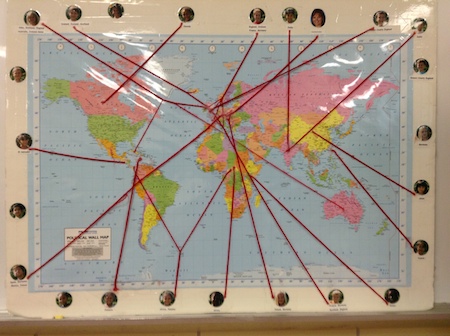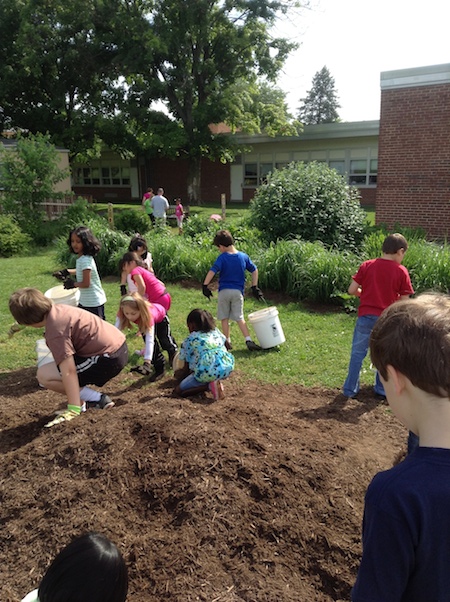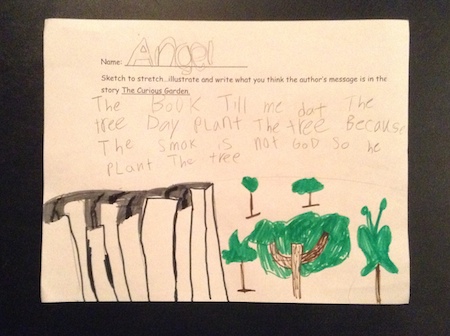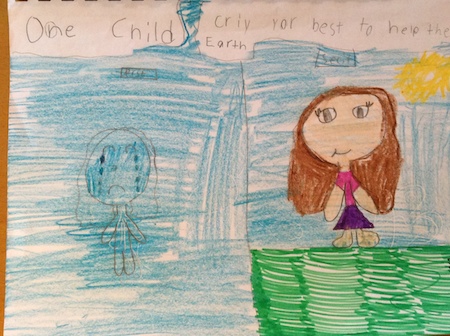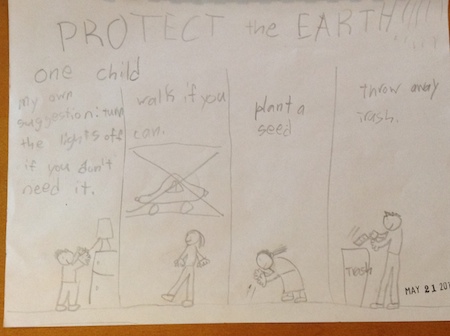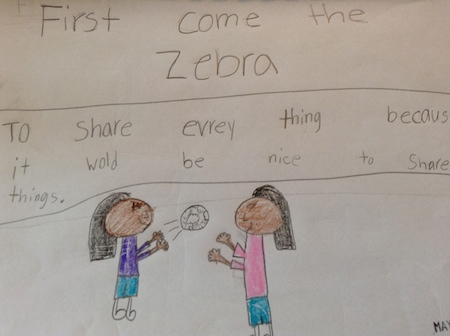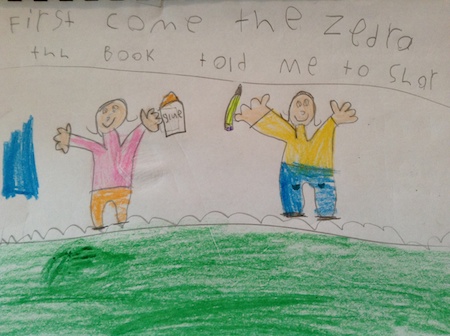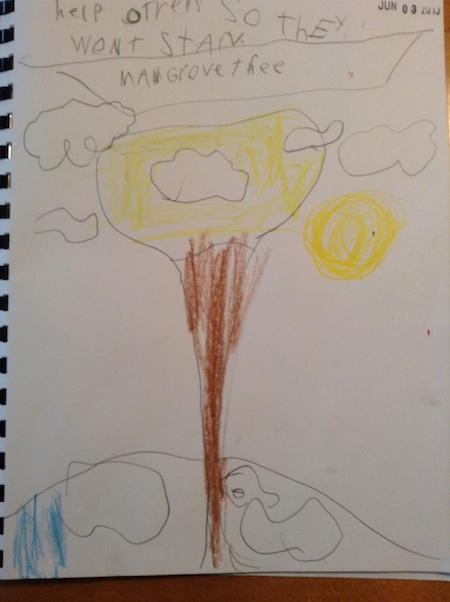First Graders Taking Action in Their Part of the World
by Michelle Hassay Doyle, First Grade
For the past several years I have been exploring ways of using global literature in the classroom. We have based much of our work as a literacy community on A Curriculum that is International, a curriculum framework developed by Kathy Short (2009). This curriculum offers various ways of engaging with global literature that encourage children to explore their personal cultural identities, ways others in the world think and live in particular cultures, different cultural perspectives related to any topic/subject, and complex global issues which can lead to ways of taking action to address problems. This year we knew we wanted to find ways of helping our students think about how they can make a difference in the world.
In this vignette, I share some of the events in my classroom related to our study of taking action, specifically what we did, and plan to continue to do, to help our part of the world. First, though, I invite you into my classroom to learn about who we are.
Welcome to My Classroom
The 22 first graders in my classroom were an amazing group of children with diverse backgrounds and heritages from all over the world. Two families had moved into the area from India during the last few years. Another family moved from China three years ago. One family that had been in our school for several years was preparing to move back to their native country of Taiwan. Other families had moved from Kenya, England, Jamaica, Germany, Africa, Mexico, and El Salvador within the last decade.
My classroom is a rich literate environment. More than half of the room is filled with picturebooks and chapter books in a reading area that also includes two large carpets, comfy chairs and a small sofa where I hold reading conferences with students. Writing materials are also accessible around the room. Throughout the year we studied various author/illustrators which provided opportunities for students to make deliberate decisions about their writing and art. Our motto all year was “the more you read, the better reader you will become and the more you write, the better writer you will become.” This helped students focus and become stronger readers and writers. In addition, students learned to communicate through art. They were very thoughtful about what they were illustrating, making decisions about, for example, which colors and lines to use to convey particular moods or show emotion.
We started the year with a focus on identity and understanding who we are as cultural beings. I sent home the family survey, asking parents about their heritage, where their ancestors originated and immigrated from, and when/what brought them to the United States. While this was difficult for the children to understand (some say, “But I was born in Baltimore”) it began to give them a sense of their place in time and helped them realize every family was from somewhere else unless they were Native Americans. I took pictures of each child and placed each child’s face on the outside of a world map, with a string connecting them to the country/ countries they were from. The students loved this and referred to this map throughout the school year (see Figure 1).
Having regular class meetings provided every student with an opportunity to state their opinions. Our meetings were also a place where we discussed issues that arose and how we could solve them together. Our first class meetings at the beginning of the school year focused on getting to know each other and on the kind of classroom we wanted to have. We worked hard to learn each other’s names and interests and discussed how we think we should act towards each other. This past year we decided to have one rule: “Treat others and the environment the way you wish to be treated.” We explored what this meant within our classroom walls, in the school building and in our outdoor classroom environments both on the playground and on the school grounds.
Pot Spring Elementary is a “Green School” in terms of environmental concerns so we have a lot of wonderful areas on our school grounds that evolved out of the school mission, including a meadow, a rain garden, a trail of native trees planted over the years, a Bayscape garden, and a bluebird trail. We simultaneously worked to develop respect for each other and our differences and respect for our outdoor world.
Taking Action in the Classroom
As Laura Fuhrman described in her vignette, our classes did a cross-cultural study of India that was also woven into the curriculum outside of our classrooms in collaboration with the special area teachers, such as art, P.E., and technology. During this study we stayed alert to issues the children gravitated towards. For example, they were very taken with water issues in India and how in some areas families had to get water from wells and carry it to their homes. The children were also interested in how some children attended school, with classrooms being sometimes set up under overpasses on highways or on train platforms when buildings and teachers were scarce. The issues that really captivated students, though, were those related to the environment, including endangered animals and plants. Environmental issues became our focus for “taking action” because it was authentic and significant to the children and related also to their experiences in Maryland (Short, 2011).
Because we are a Green School and had a continual focus on respecting, working with, and helping each other, I realized that we had been finding ways to take action and make our world a better place throughout the year. A primary focus of our action was our school’s Bayscape garden (see Figure 2).
The Bayscape is filled with native plants that were originally placed in this location to control erosion at the bottom of the hill right outside of our first grade classrooms. The Bayscape is located closest to our classroom and is one of the projects that we have helped to maintain over the past few years. After studying the native plants and pulling weeds in the garden children developed a respect and a sense of ownership and protectiveness for this area. Since the Bayscape is not a fenced in area and sits at the bottom of the field on which the children play, it is a magnet for balls. Students quickly discovered the importance of keeping the area safe from trampling feet so the Bayscape would not be harmed. With partners they made posters to inform others to stay out of the Bayscape. Their posters said things like “Please do not run in the Bayscape, plants are growing there!” and “Do not litter in the Bayscape!” Once the posters were created students wrote statements about them, then delivered the posters to each classroom in the school to hang as reminders of why it was important to stay out of the Bayscape. They also took turns reminding everyone in the school during the announcements each morning. These actions helped students learn about how they can make a difference and take action to help the world around them. My favorite part of this inquiry was that children became ambassadors for protecting the Bayscape and worked hard to remind other classes to direct their balls and feet in other directions! They had a voice right from the start of the year.
I used global literature to develop students’ understandings of the concept of “taking action” and as a springboard for discussions of the range of ways they could make a difference. Often students responded to the books we read by creating a sketch-to-stretch (Short, Harste, & Burke, 1996) in their journals. We started with The Curious Garden (Brown, 2009), in which a boy who lives in the city discovers an area where plants are growing on abandoned railroad tracks. He nurtures these plants and eventually the whole city becomes a more beautiful and greener place. Students loved this book and were able to understand how the actions of one boy made a difference in his part of the world. In our class discussion, Ben summarized by stating, “One boy helps make the world around him a greener and more beautiful place.” Angel, a second language learner, created the sketch-to-stretch in Figure 3.
Angel uses the illustrations from the picturebook as an example to depict the area as very gray due to the factories nearby. By the end of the book the boy has inspired the community to plant trees and plants, replacing their drab world with beautiful colors.
In One Child (Cheng, 2000) the illustrations are a powerful part of telling the story. The images are very dark and gray in the beginning, because the girl, the “one child”, is saddened by her discoveries of a world filled with pollution, people killing animals, and people fighting. As the story progresses and the girl talks about her dreams of making the world a better place, Woolman, the artist, incorporates more and more color. Students picked up on this immediately. In her sketch-to-stretch Kayla shows this concept and incorporates the feeling of the girl at the beginning and end of the story (see Figure 4).
Through her use of color Kayla shows the sadness the girl feels at the beginning of the story and the joy by the end of the story as the girl thinks of ways she can make a difference. Claire went a step farther by adding a series of examples of things people could do right now (see Figure 5).
Claire wrote about turning off lights when they are not needed, walking when you are able, planting a seed and throwing away trash. Khyree summarized One Child by saying, “One girl’s world was gray and she realized that if you stop littering and start planting you can make a difference in the world. If you can IMAGINE, anything can happen.”
Another book we read was First Come the Zebra (Barash, 2009) about two neighboring tribes in Africa that did not get along. Two young boys, one from each tribe, work together to help save the life of a toddler who wanders into harm’s way. Christina’s sketch-to-stretch showing her understandings of this book is in Figure 6.
Christina picked up the concept of sharing with each other because it is “nice to share things”. During our class discussion, Christina stated, “we should treat others the way we want to be treated, we should be nice to each other and share” to which Alex added, “that is our golden rule, to treat others and the environment the way we wish to be treated!”
Jessie related this story to her own life (see Figure 7). Jessie wrote that “the book told me to share” and she illustrated this marvelously by showing children sharing their glue and pencils with each other.
A final example of a book we read about taking action was The Mangrove Tree: Planting Trees to feed Families (Roth & Trumbore, 2011). Khyree summarized the book during a class discussion by stating, “One scientist lead a project to plant mangrove trees so that a village could survive and not starve.” In his sketch-to-stretch (Figure 8) he wrote, “Help others so they won’t starve”. He represented his understanding by drawing a giant Mangrove tree reaching to the sky for all to share.
To pull together our thinking about the taking action books we had read, we created a chart identifying common characteristics of these books. During our discussions children shared ideas, such as how the books were about making the world better, how people were able to make changes in the world, and how we, too, were making the world a better place by pulling weeds and mulching our Bayscape. Rashmi summed up everything when she said, “In each world [the character] made the world a better place,” which is at the heart of taking action.
Reflecting Back and Thinking Forward to Take Action
As the year wound down, I wanted to find a way to reflect back on our thinking about taking action and help students look forward to what they would continue to do. To start the reflection process, I first had students write about things we’d read about and done over the year to make our world a better place. They wrote on their own first, then I made the list from their ideas on a chart and we reviewed them. Their ideas included picking up litter and trash and cleaning up their neighborhoods; mulching and weeding our Bayscape; protecting endangered animals; and, helping birds by feeding and providing houses for the Bluebirds, a native bird of Maryland, perhaps referencing the Bluebird trail on the school property that was created over the years as part of our Green School project. Students helped to maintain and monitor the bird houses during the spring. Students also included ideas from a science unit we’d just completed that focused on our endangered state butterfly, the Checkerspot. We learned that deer are eating the Turtlehead plant that the Checkerspot needs to live and so planted Turtlehead plants in the Bayscape. Students realized that they were already doing a huge amount to take action to help our part of the world!
After our brainstorming, we read 10 Things I Can Do to Help My World (Walsh, 2012) and decided to make our own class book, titled 22 Ways to Help the Earth. Children thought of ways that they could help the world and provided a reason for why their action was important. A sampling of the pages from our book are in Figure 9.
Figure 9
This year was magical. Students were perceptive, persistent and extremely motivated to do their very best to make a difference. The theme of taking action was woven throughout our year and so they grew in their understanding of its importance and their role and responsibility in making a difference in our world. I truly feel that the seeds were planted and hope they take root as these children grow throughout their lives. I feel lucky to have been with them on the beginning of their journey.
References
Barasch, L. (2009). First come the zebra. New York: Lee & Low.
Brown, P. (2009). The curious garden. New York: Little, Brown.
Cheng, C. (2000). One child. Illus. by S. Woolman. New York: Interlink.
Roth, S., & Trumbore, C. (2011). The Mangrove Tree: Planting Trees to feed Families. New York: Lee & Lows.
Short, K. (2009). Critically reading the word and the world: Building intercultural understanding through literature. Bookbird: A Journal of International Children’s Literature, 47 (2), 1-10.
Short, K. (2011). Children taking action within global inquiries. The Dragon Lode, 29(2), 50-59.
Short, K., Harste, J., & Burke, C. 1996. Creating classrooms for authors and inquirers. Portsmouth, NH: Heinemann.
Walsh, M. (2012). 10 things I can do to help my world. Somerville, MA: Candlewick.
Michelle Hassay Doyle teaches first grade at Pot Spring Elementary School in Timonium, Maryland.
WOW Stories, Volume IV, Issue 7a by Worlds of Words is licensed under a Creative Commons Attribution-NonCommercial-ShareAlike 4.0 International License.
Based on a work at <a href="wowlit.org/on-line-publications/stories/storeisiv7a".

